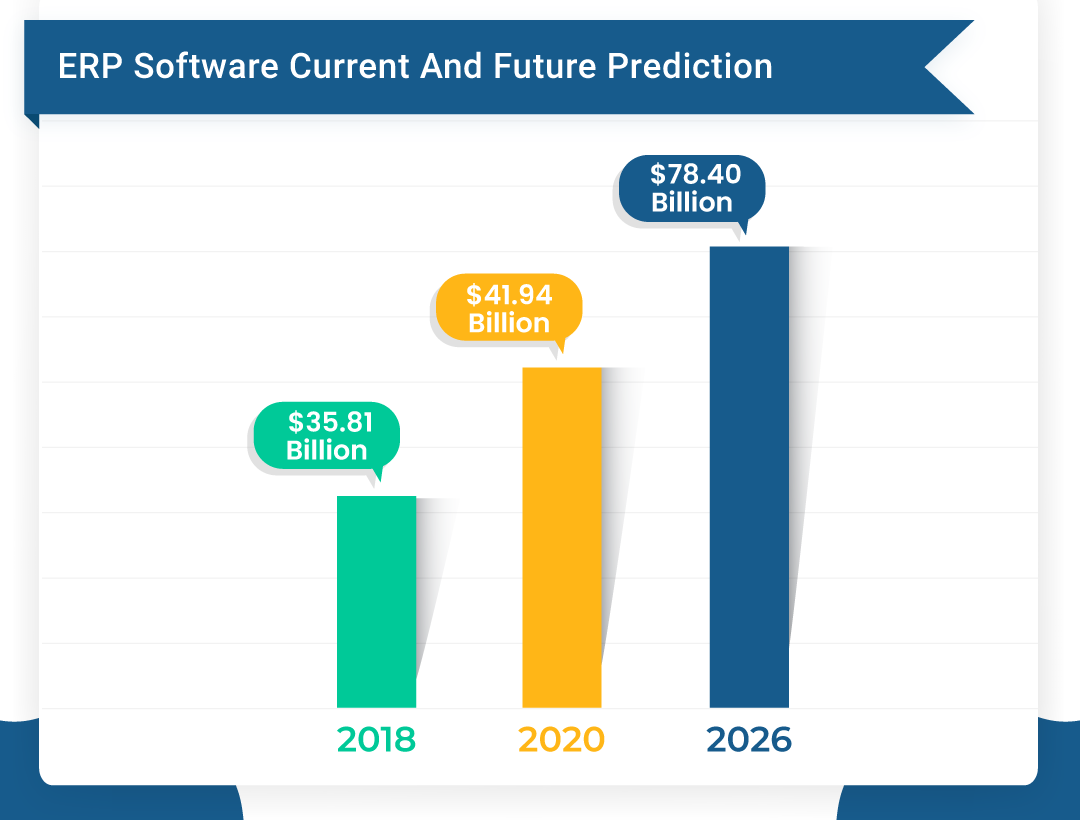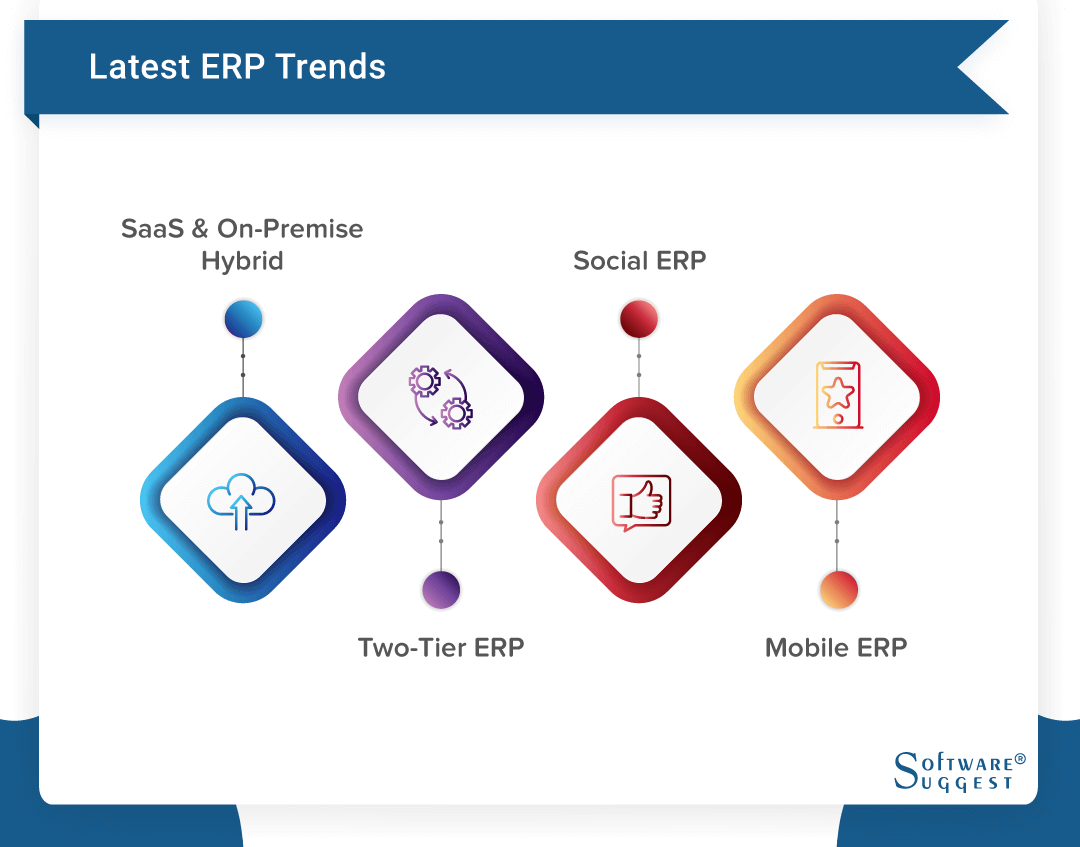Enterprise resource planning software systems are now considered in the list of basic requirements for the management of a business. From planning to managing, it is used in core manufacturing services, financial processes, and much more in an organization.
Today in our blog, we will discuss the ERP Facts and Statistics that you need to follow. These details and figures will help you in selecting an effective ERP system for your organization according to your needs and requirements.
Current and Future ERP Market Statistics
The Gartner Group introduced the concept of Enterprise Resource Planning in the early 1990s. However, ERP systems and software are being used for around 100 years, and they are quite popular in the manufacturing industry.
ERP Facts and Statistics
- The 1980s- Evolution of computer technologies and software-based business activities such as CRM or customer relationship management, human resources data, and finance.
- 1983- A new MRP II was introduced that featured “modules.” It integrated the essential manufacturing components and tasks that form a shared-data system.
- In the 2000s- Gartner Group devices the term ERP to distinguish the system from MRP software. This new system encompasses business intelligence and handles other important business functions like SFA (Sales Force Automation), eCommerce, and marketing automation.
- 2005- Enterprise Resource Planning Solution was made Cloud-based. It created Internet Enabled commodities that provided an alternative to the conventional on-premise customer server models.
- Now- SaaS or Software-as-a-Service and XaaS or Anything-as-a-Service are introduced as the new delivery systems for ERP. The web-based remote access for ERP solutions offers security, mobile solutions, smart technologies, the Internet of Things or IoT, Internet of Everything, or IoE.
- Future: It is said that the global market revenue of ERP is expected to get hike by $47 billion in the coming 5 years. ERPs will become a priority investment for business organizations.
Selection decisions by global organizations for ERP software as of 2022
- The ERP facts and statistics depict valuable information on the selection decisions of organizations related to the ERP systems across different countries as of 2022. During the survey period, 23% of the respondents said that their companies went for an up-gradation of the current ERP system, while 13% stated that their companies shifted to an upper Tier ERP vendor.
- The Global IT expenditure in 2022 is expected to be around 4.68 trillion US dollars, which shows a 4.3 % growth.
- Global spending on multiple devices like tablets, PCs, mobile phones, or printers was around 698 billion USD in 2019. In 2020, the same is estimated to fall by 15.5% in 2020, which is around 590 billion USD. This is due to the recession caused by the COVID-19 pandemic.
- The infrastructure software sector of the IT market accounted for 41.3% of the entire market share in June 2019. The hardware-based sector such as the storage and server system accounts for a smaller portion of the total market compared to software-based segments.
- Global revenue for application software is estimated to reach 302 billion USD by 2023.

ERP implementation statistics
Execution of a successful ERP implementation requires companies to have a vivid vision of the prerequisites of a new system. This would create alignments within the organization. You can increase the probability of a successful project by selecting an efficient vendor and also assigning a central and internal implementation group.
Though ERP implementations are quite challenging, ERP facts and statistics show that many organizations are surpassing the expectations of efficient implementations.
- A survey was held in 2019 among all the manufacturers and distributors, in which 67% of them claimed the implementations to be successful in terms of internal elements of the organization such as management support, efficient management programs, due diligence, etc.
- Among the implementation downfalls, an insignificant 12% found the software to be of subpar quality.
- Around 50% of ERP implementations fail the first time.
- The main 2 problems that cropped up during implementation involved insufficient testing and insufficient process re-engineering.
- Once the implementation was complete, 49% of the organizations stated that ERP improved the entire business process. However, only 5% of them did not find it beneficial.
- An ERP implementation survey showed that mid-scale companies that earn $100 million to $250 million experienced the fastest implementation at just 6.6 months. Large companies with more than $25 billion in revenue took more than 12.35 months to implement.
- The implementation process needed minor customization by 10% of respondents.
The most used ERP system in the industry
-
Oracle ERP
Oracle ERP Cloud is the most used ERP system and it is by far the best one in this industry. The users have rated this system with security features as the most efficient ERP across 10 ERP providers.
Oracle’s acquisition of SaaS tools of NetSuite has proved to be successful for the company in offering add-on functionality.
-
SAP
SAP does not fail to give tough competition to Oracle. It has proved to be a frontrunner for very large enterprises. However, the implementation process of SAP is quite long but it is customizable for any organization according to its requirement.
Microsoft ERP
Microsoft provides the ultimate ERP solution to every business. For those who are using Microsoft products, opting for Microsoft ERP would be a smart choice.
ERP software worldwide market revenues from 2018 to 2025
One of the ERP facts and statistics is that worldwide is estimated to reach a revenue of 48.21 billion USD by 2025. This is a significant growth rate of 7.88% CAGR from 2020. In 2019, ERP implementation became one of the best practices worldwide that brought and automated the entire business operations into a simple and single solution.
The ERP software penetration worldwide in small and mid-sized organizations was quite low because of the high deployment costs in 2018. However, this cost of deployment has continually been declining with the introduction of a cloud-based ERP system.
Hence, the new cloud-based ERP has been experiencing enormous growth rates among small and medium-sized companies since 2018. It is estimated to take over 40% of the market share or more by 2025.
Cloud ERP system statistics
The use of cloud technology ERP systems continues to rise worldwide since businesses are shifting on-site technology to gain additional business efficiencies, network elasticities, on-demand or off-demand services, and increased network access. The ERP statistics on the growth of this cloud-based technology also show a substantial growth in cloud applications.
- Forrester estimated that cloud subscriptions in 2020 for different business applications would bring revenue of about $170 billion.
- Cloud technology ERP systems experienced an application growth rate of about 20.7% in 2018.
- The cloud application spending is expected to reach 227 billion USD while cloud services are expected to reach 70 billion USD by 2022.
- A survey on ERP users was conducted globally that showed 64% of the businesses use SaaS, 21% percent use Cloud ERP and the remaining 15% use on-premises.
- The deployments of the Cloud account for about 44% of implementation for respondents in the distribution and manufacturing sectors.
The Current and Potential Problems Faced in ERP Systems
ERP applications are like any other platform that comes with challenges and problems. The issues may range from scalability issues to installation challenges. You may want to know the potential problems faced in ERP systems while using enterprise resource planning solutions-
-
- The main challenge of using ERP systems is organizational challenges. This could be a potential reason why your ERP projects are missing the given deadlines.
- ERP systems are inadequately flexible. An organization may need to adapt to the system or processes of ERP to make it work efficiently. Most ERP implementations may fail to work on the first try.
- Despite the benefits of using ERP systems, users just do not want to replace their existing integral system with ERP. This is because a change may lead to inevitable delays and resistance from the team.
- Every ERP system requires regular maintenance, adding maintenance costs to the allotted budget. 64% of ERP projects require a relatively high budget.
- The functionality of ERP systems may be restricted which affects the existing efficient practices. It is important to vet the vendors before implementing a new ERP software.
ERP Facts and Trends: Future of Enterprise Resource Planning

One of the future ERP facts and statistics is ERP software solutions revenue is projected to hit 78.4 billion USD by 2026. It would represent a CAGR of 11% from the current ERP software market size at approx. 41.9 billion USD. This growth is in line with the digitization of business, using tools to optimize day-to-day business activities. In addition, ERPs are equipped with modules from accounting to project management systems, making them almost ubiquitous for all organizations.
Trends tend to follow the latest developments in ERP technologies. Here, we have compiled some significant trends observed among the ERP vendors.

-
SaaS & On-Premise hybrid:
Many companies prefer a hybrid ERP approach, i.e., integrating on-premise software to the cloud platform. For example, let’s say integrating cloud payroll into local HR-focused ERP. In the context of cost and process, this strategy seems meaningful. Thus, software vendors tend to offer hybrid ERP. For instance, Oracle is co-opting it with cloud solutions instead of replacing its on-premise ERP licensing.
-
Two-tier:
Two-tier ERP vendors involve two systems in a single company. Most multinational companies are moving towards this approach where tier 1 software is used in ERP at the corporate level, and tier 2 is used at the branch/subsidiary level. This strategy proves helpful when big corporations find it difficult to implement an overarching infrastructure due to cultural, geopolitical, and market differences.
-
Social software is used in ERP to add data from social media platforms like Twitter and Facebook into the system. It is a CRM initiative as most businesses are involved in online customer engagement, brand mentions, friend networks, public data, likes, and shares to obtain customer knowledge. As a result, it helps them improve conversion rates.
-
Mobile:
Some solutions provide native apps for Android, iOS, and Windows. It allows employees to stay connected and productive even outside the office. But, accessing data anywhere on a device the company does not issue is prone to a security breach. Mobile ERP solves this issue by providing different user permission that helps the company control who can access data on their phones.
ERP Trends will Revolutionize Business World!
2022 will see the emergence of various new ERP trends that will change the way companies conduct their businesses. While the evolution of the software will bring complications and hurdles, the benefits will overshadow the limitations.
For small and mid-sized businesses, ERP software will boost growth. So, stay up-to-date with the trends and apply the latest technologies to your operations and gain a competitive advantage.
Final thoughts
Looking at these ERP facts and statistics, we can definitely predict one thing using ERP is a must for better business management in the future. Its growth is inevitable.
So, what are your thoughts on it? Do you find this information useful? Do let us know your views in the comment section below.
A digital marketing and content curator at SoftwareSuggest, a software recommendation platform. I am passionate about Digital Marketing, and all things digital. Also interested in technology and innovation. In my spare time, enjoy playing cricket, and Badminton.



